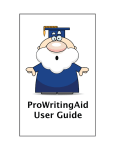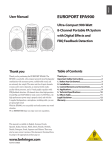Download Wiley Your Google Game Plan for Success: Increasing Your Web Presence with Google AdWords, Analytics and Website Optimizer
Transcript
Part I D MA TE RI AL Getting Started TE In This Part CO PY RI GH Chapter 1: What’s Your Game Plan for Success? CHAPTER 1 What’s Your Game Plan for Success? In high school I was in a program called the Junior Reserve Officers Training Corps (JROTC). Our senior Army instructor was a retired U.S. Army colonel (a “full-bird” colonel, as he would emphasize). He was a tough, no-nonsense leader who preached the values of teamwork against the backdrop of our own motto: “Leadership. Citizenship. Challenge. Responsibility.” One of the colonel’s pet peeves in life was a poorly designed lesson plan. The only thing worse than a poorly designed lesson plan was no lesson plan at all. He would vent to us about how frustrated he was made by the horribly inadequate lesson plans of some of the school’s faculty. We even had lesson-plan workshops, where we outlined our own plans and executed them to judge their effectiveness. When you’re exposed to something like this at age 14, it kind of sticks with you for the rest of your life. It always amazes, confuses, and intrigues me when businesspeople don’t have some kind of plan of action — some kind of direction. You can hear it in the way they speak to you, you can see it in the way their website or marketing material is designed, and you can just feel it in your bones. You would think that having a game plan would be the most obvious and first thing a business owner would want to do — I mean, how can you start doing business without one? Unfortunately, lots and lots of website owners don’t have any plan or any direction whatsoever, and some who do are going on a cross-country road trip without a GPS device. Before you dive into Google AdWords, Google Analytics, and Google Website Optimizer, I highly recommend that you digest this first chapter, especially if 3 4 Part I n Getting Started you’re thinking about or are in the middle of your first foray into doing business on the World Wide Web. You’re going to get a good sense of how you should be thinking as an owner or marketer of a website, or even as someone who performs technical updates to a website. What’s Your Current Plan of Online Action? Whether you’ve just finished designing and uploading your first website or are on your 15th different redesign since 1993, there are some high-level philosophical and introspective questions that you really should be asking yourself. When I talk about having a “game plan,” I’m not suggesting that you start creating accurately organized spreadsheets outlining every single second of your business life. The “Type A” brain in me would love to have you do just that, but my more abstract side wants you just to have an awareness at this time of what your answers would be to the questions in the following five sections. These questions are very simple, yet often forgotten, and they really need to be addressed before you do anything else. If you’ve never thought about or been posed these questions, then I have already accomplished one of the personal goals I have regarding you, the reader, in this book — and we’re only a few pages in! Why Did You Build a Website? You wouldn’t think that a question this simple would be one of the most difficult to answer, but it’s true. Why did you — the soon-to-be-master of all things Google — spend all that money and invest all that time? Was it just because having a website is something everyone else was doing? Do you have a product to sell that will change the course of history? Are you a multinational conglomerate or nonprofit organization that wishes to spread its message to the masses? Did you build your e-business five years ago for one reason, but now find this has evolved into a completely new set of reasons? Answering this fundamental website question will actually help you put your entire online presence in perspective, and you’ll be a better person for it, guaranteed. What Does Your Website Look Like? People in general have very short attention spans and even less in the way of patience. They want websites to load faster than electronically possible and they want the best deals and discount codes available on the Net. When they visit your website for the very first time, they are subconsciously determining if they like your site or not, and in that same fraction of time, they’re deciding whether to continue or go back to Google and try another search result. Chapter 1 n What’s Your Game Plan for Success? So let’s say that your website passes that first mental checkpoint for the typical visitor. Now, your website also has to do something apart from just being visually attractive. It has to be enticing. It has to be engaging. It has to be persuasive. If you’re trying to sell a product online, you’d better be really engaging; otherwise visitors to your site will not want to continue with you after the initial impression. Take a quick peek at Figure 1-1 from DIRECTV’s homepage. DIRECTV has some satellite television service to sell you, and it makes sure you know about it without totally overwhelming you and rubbing it in your face. The company isn’t passive about it, since it doesn’t want to be confused with an informational type of site, but the approach is also not incredibly aggressive, so you won’t confuse DIRECTV with a get-rich-quick scheme or some late-night infomercial. The question “What does your website look like?” doesn’t ask only about aesthetically pleasing qualities (which I will cover in depth in the Google Website Optimizer chapters of the book). It also asks what you are doing on the website to keep the attention of visitors so they’ll hang around for more than just a few seconds. Figure 1-1: DIRECTV’s homepage 5 6 Part I n Getting Started What Does Your Website Do? Currently, most sites on the Web don’t do much of anything, except provide the visitor with content (a lot of websites don’t even do that). However, with the influx of more and more technologically advanced websites, visitors are beginning to expect any website they visit to do more and more for them. What was acceptable in 1999 or 2004 is now passé, and what was yesterday’s news is today’s history. Throw in the social-media explosion of the last decade, and you get a fusion of all sorts of different websites scattered throughout the Internet, all doing an array of different things. Understand what it is your website does before opening up an AdWords account and sending a bunch of traffic to your landing pages. Also understand what it doesn’t do, and if it’s something that you feel your web constituency doesn’t need. There’s nothing wrong at all with a “basic” website (e.g., one with no “Web 2.0” – based interactive applications, complex Flash pieces, or studioquality videos). Just make sure that you’re getting your message across clearly to your site visitors, engage your visitors properly to start to do business with them, and don’t force your website to pretend to be something it’s not. How Does Someone Benefit from Your Website? On the Web, especially with a new site, you’re going to have to be extremely good to make a profit. Depending on what your online business model is, this question may have added importance for you. Whatever you do online, there’s a good chance someone else is already doing it much better. Your great idea may be already in motion and being executed by someone else. And your “can’t live without” revolutionary product of the century may not be as good as the “really can’t live without” product of the millennium that your competitor is all over. However, that doesn’t mean you can’t still be really good at what you do, and have one of the best sites on the Web. It takes a lot of work and it may not come easy for you. You’ll need to do market research, learn about your industry vertical, perform continuous testing to improve your website, and, most importantly, offer your visitors a benefit that they will appreciate and tell all their friends about. Part of being great online is having the uncanny skill to make visitors feel as if they’re getting an inside deal, a very special offer, or the inside track on the best product or service known to man. Take Figure 1-2, for example, which is eHarmony’s homepage. The two things that you should immediately notice are the “Curious about how eHarmony works?” message at the top right, and then the word “FREE” followed by “to Review Your Matches” on the left-hand side (eHarmony also mentions this toward the bottom of the page). So not only is eHarmony trying to give you an inside look at how its system works, but it also presents an advantage to joining — the ability to review your matches for free. This is the kind of thing your website needs to do in order to attract visitors at a deeper level. Chapter 1 n What’s Your Game Plan for Success? Figure 1-2: eHarmony’s homepage If you’re not doing it, there are a dozen other websites out there that will do it instead. You really can’t afford not to provide some kind of benefit to your site’s traffic that no other site can match. If you can do that and market it better than anyone, all of a sudden your bright orange background and cheesy horizontal banner ad don’t seem that annoying. And what’s more, your asking price doesn’t seem as high. See where this is going? How Do You Plan on Marketing Your Website? Finally we get to the point where we ask ourselves, “How in the world am I going to get eyeballs and clicks on my site?” Because you’re reading this book, you’re either using or interested in using Google AdWords, which is an excellent, cost-effective choice. But what else are you going to do to keep the traffic coming and coming? On the Web, there are no rules saying that if you’ve had a website since 2000, you’re automatically entitled to free traffic that will convert at the same high rate of success a kid fresh out of college is getting. Just because you’ve been around 7 8 Part I n Getting Started for a decade and your tagline says you’re the best, that doesn’t mean you have a right to the traffic and transactions that the kid with a six-month-old site is “stealing” from you. The Web doesn’t care how long you’ve been doing it — it cares only about how well you’re doing it. How you plan your marketing strategy as you move forward can’t be about ego or a sense of entitlement. It has to be about a consistent, dedicated effort to continue to optimize your marketing campaigns, your website’s marketing message, and your website as a whole for search engine optimization. But it doesn’t even end there. Your offline marketing affects your online marketing, and vice versa. Your TV, radio, and print ads have a big-time effect on the ultimate success of your website, and your website can mean the difference between success and failure for your offline efforts. Let’s try to avoid the latter by making sure that your ads are in sync with each other across different marketing channels and different marketing media for optimal results. You’ll definitely read more about this as the book progresses. Now that you’ve digested these five baseline questions a little bit, let’s switch gears and talk about something else that’s very important and unfortunately often mired in ignorance: how success is measured online. How Are You Measuring Success? Let’s hope you already have an answer at the ready when you think about this next subsection of Chapter 1. It doesn’t have to be the perfect answer, a right answer, or even a fully qualified answer. You should be able to come up with something that is useful for you to measure success. Perhaps this is what you did when you originally launched your site way back in the day, or maybe your boss asked you some questions and you had to dig deep and provide some kind of answer. The good news is that you’re measuring success. Or at least someone asked you to compile some figures so that that person can attempt to measure success. The bad news is that most people don’t know how to measure success. But that’s OK — everyone has to start somewhere. A lot of website owners don’t even care about measuring success, which sends chills up my spine. Measuring success isn’t a right or wrong answer, or a true-or-false question. You can be measuring success excellently, you can be doing a halfhearted job, or perhaps you just couldn’t care less. Most people use one or more of the next five “groups” to do their measurements. Visits, Hits, and Page Views You probably know one of these terms already — hits. This term has been around for a long time, and it used to be in the form of a counter on a lot of websites in the early to mid-1990s. It was also used in those prehistoric Internet days Chapter 1 n What’s Your Game Plan for Success? to measure success. If your site had 30,000 hits a month, you were winning. If your hit counter below the “Sign My Guestbook” link and above the animated “E-mail” icon was large, you were in charge. Boy, have we come a long, long way from those times. Or have we? I recently spoke to someone who kept referring to “hits” and “visits” and how he wanted as many of those as possible, because he read some article or spoke to some “guru friend” who told him that getting as many hits and visits as possible was the way to succeed online. Let’s hope this individual will heed the suggestions that I gave, and that this mentality is the exception, not the rule. Hits and visits are basically the same thing — I won’t go into semantics about the differences between the two. Page views are pretty much what they sound like — views of pages on your site. They’re the foundation for most of the important web analytics and online-marketing metrics that are used to measure success, and they do serve their purposes in the grand scheme of things. However, they are in no way, shape, or form a reliable, intelligent, or worthy group of metrics to measure success with. There are no additional insights, no additional information, and no additional actions that you can take from knowing how many visits or hits your site has received. Figure 1-3 shows a piece of the dashboard report from Google Analytics. This particular website has received almost 300,000 visits and well over a million page views in this time frame . . . but who cares? Where did these visits come from? What pages did these people view? Did they request quotes? Did they buy something from the store? What were their average order values? How many visits did it take most people to purchase an item? These are the questions that need answering if you are to begin to measure success online — hits, visits, and page views cannot answer these questions or provide any help beyond simply telling you how many pairs of eyeballs viewed your site. Figure 1-3: A piece of the Google Analytics dashboard Time on Site, New vs. Returning Visitors, and Events I like to group these potential success measurement metrics together because they are very tricky and slippery. Yes, slippery! Let me explain. 9 10 Part I n Getting Started Time on Site is usually reported as an average, and it’s the average amount of time, in minutes, that all visitors spend on your site. So it goes one step beyond a metric like Visits, because Average Time on Site takes all the time that all the visitors spent on your site, and reports back a ratio to you. It’s an improvement upon Visits and Page Views, and for some websites it can be of a higher importance, but it’s nowhere near where we want to be. It’s a start, at best. Something like Average Time on Site, which you see in Figure 1-4, doesn’t allow you to evaluate performance. In Figure 1-4, you can clearly see in the upper-left corner that the Average Time on Site is two minutes and forty-eight seconds. You can also see a distribution by day of the same metric. But what you can’t take away from this metric or this screenshot is whether two minutes and forty-eight seconds is good for you, bad for you, or neutral. Did visitors spend only that average amount of time on your site before they were frustrated with it and left? Did they spend all that time trying to figure out how to use your search function? Did they visit 10 different pages and then place a rush order with gift wrapping and next-day shipping? We cannot infer any of that, but in general, the more time visitors spend on your site, the higher the chances that they will convert (but not always — there are a lot of exceptions to that general rule). Figure 1-4: Average Time on Site graph Chapter 1 n What’s Your Game Plan for Success? Similar challenges for measuring success arise when you look at a report like the New vs. Returning Visitor report. Here, Google Analytics (or whatever webanalytics program you’re using) can determine the percentage of visitors who have visited your site only once, and the percentage who have visited twice or more. Figure 1-5 shows this very popular pie chart found within the Visitors section of Google Analytics; it’s also found prominently in nearly every web-analytics package. Figure 1-5: New vs. Returning Visitor report Figure 1-5 shows a breakdown between new and returning visitors that’s as nearly “classic” as you can get — a 70/30 percentage split. But as with Average Time on Site, where do you go from here? Without segmenting, applying a daterange comparison, or digging any further, you can’t really do much with this report other than add it to your own knowledge of what is happening with your website. Great for your knowledge and understanding, not so great for measuring online success. Events — interactions with special website objects or functionalities that do not generate page views — are also very tricky to measure for success, because again they are simply counts of raw things that happen on your site, without much meaningful weight associated with them. Is it important to track events from your video players or your brand-new Web 2.0 – based artwork designer? It definitely is — you need to know what people are using and what you can optimize and improve upon. Can knowing the number of clicks on your play button help you measure success on your website? Probably not, unless you’re somehow charging money for every minute that’s viewed on your videos, or if visitors can somehow get to a brochure download or lead-generation form from your advanced website functionality. Conversions, Goals, and Successes Now we’re really cooking! If you’re looking to improve your rate of form submissions, the number of times someone downloads your services brochure, or the number of items ordered from your online store, you’re definitely on the right path to measuring success! 11 12 Part I n Getting Started You see, it doesn’t matter how long visitors spend on our sites or how many visitors there are, or how many pages they viewed. The question that should always hang over your website is, “Did these visitors perform specific important tasks on my site?” Visiting your homepage, viewing your “About Us” page, and looking at your executive bios are nowhere near as important or special as submitting a form to receive a white paper or contacting you to receive more information about product X, Y, or Z. All your marketing efforts — be they online or offline — should be geared toward continually improving these highly important website actions. If you don’t currently think about what actions you want your website’s visitors to perform, log on to your site today and think about three or four very important things you’d want a visitor to do. Sometimes these actions will be very obvious, like the action of buying something. But a lot of websites aren’t e-commerce storefronts, so sometimes they aren’t obvious. Another general rule of thumb: If visitors have to use their keyboards on your site, chances are extremely high that whatever they had to use those keyboards for is something really important — and you should consider that a success point of your site. Customer/Visitor Feedback Do you take feedback from your website visitors? Do you ask them about their visit to your site, much as bed-and-breakfast hosts will ask you about your stay? If you don’t have any way to listen to the voice of your most important person, the website visitor, you should listen up. When I used to work for Publix Supermarkets, straight out of high school, a pie chart in the break room showed what feedback shoppers would usually give to a friend or family member about their shopping experience. It showed that 8 of 10 people would give negative feedback, 1 of 10 would give no feedback, and 1 of 10 people would give positive feedback. People in general are much more likely to give you feedback about the things that you’re doing wrong or poorly than they are to give you feedback about how awesome you are and what a great product or service you provide. So when you see books on Amazon or reviews on Expedia and there are dozens and dozens of five-star reviews, you know you’ve found something good. Since no website, including yours, is perfect, you should provide some type of customer feedback tool on your site. Collect enough feedback pieces and you’ll probably see similarities in the problems that visitors are having on your site. A lot of times, these problems are not obvious to you or people who are very close to the site, and you need outside opinions and voices to help you figure out a better way. It’s a great, inexpensive, and intelligent way to improve your website for everyone. In Chapter 17, I’ll talk about some of the better tools that you can use to collect this very important visitor feedback. Chapter 1 n What’s Your Game Plan for Success? Key Performance Indicators (KPI) OK, if you’re doing this already, then you are at a higher level of measurement knowledge than most people. Congratulations to you! Key Performance Indicators are the solutions to the mini-equations that you’ve built to measure how your website is performing. They are not metrics, like Average Time on Site or Bounce Rate, and they are not counts of things, like Transactions or Goal Conversions. KPIs, as they are abbreviated, help you understand your website’s performance at both a macro and a micro level. Something like Returning Customer Average Order Value or Google AdWords per Visit Value can be a KPI for your website, since you can dissect and segment that number in many ways. Two or three particular KPIs are very important, no matter what type of website you own or work for. KPIs are so important that numerous blogs and articles are written about them, and there is a Big Book of Key Performance Indicators, by Eric Peterson, one of this field’s outstanding contributors. You can also flip the KPI concept upside down and come up with what’s known as a Key Risk Indicator, or KRI. For example, if your New Visitor White Paper Download Rate drops below a certain level, you will know quickly that the marketing effort or change you made is putting you at risk of losing a lot of money. It’s like an early-warning system, sounding a general alarm to you to make changes ASAP or pull the plug. Doing It Online Is Different from Doing It Offline That headline is probably the biggest understatement of the entire book! Online marketing, branding, and presence is a completely different beast than offline marketing, branding, and presence. Many of you may be thinking about advertising online for the first time, and you may have backgrounds in traditional media (radio, TV, or print). I’m not going to debate whether online media is better or worse than offline media, and I’m not going to ask you to choose between them. I think more and more online marketers are starting to realize that offline marketing isn’t “dead” and that it is still — and probably always will be — a powerful and effective form of marketing. Online marketing is simply a different medium, reaching some of the same offline audience but a whole other slice of the population pie that won’t hear, see, or read your traditional advertisement. I also feel that traditional marketers are beginning to be influenced by what’s going on with their online counterparts, which is (I hope) leading to some updates, changes in the ways things are done, and, of course, more competitive prices for us online folks! Online marketing is currently doing three things that really differentiate it from offline advertising. 13 14 Part I n Getting Started Fast, Faster, Fastest! Let’s say that I’ve just launched my brand-new AdWords campaign, targeted to the state of Florida and running during business hours only, Monday through Friday, with a cost per lead of $25. It’s chock-full of different ad groups, keywords, and negatives. It took a lot of work to put all this together and it’s finally up and running! But — oh, no! — there’s a misspelled word in my top branding ad, and it’s very embarrassing! Heaven forbid anyone should see this shameful error; I will be laughed right off the Internet! Ahh . . . all better! In the time it took you to read those last two paragraphs, the misspelled ad has been corrected and the correction is live on Google and its Search Partners. Even though the campaign went live, you caught the error and fixed it instantly. No embarrassing typo, no lost business, no smudge on your brand. Try making a change that fast with a television commercial. Try making a change at all in a print flyer or magazine. Changes and updates can happen instantaneously online — not so much offline. No Charge for Changes Oh, by the way, I almost forgot to mention that the instantaneous change I just made didn’t cost me anything whatsoever. In the cost-per-click online marketing world, you’re charged only for the clicks on your ads — nothing else. You’re not charged operating costs (unless you work with an agency running your campaigns for you), you’re not charged for making any changes or creating any new campaigns, and in most cases you’re not even charged for impressions (eyeballs) that view your ads. Isn’t that wonderful? With a traditional marketing contract you may not be so lucky. Much Higher Level of Accountability Just launched a campaign at eight in the morning? You should have preliminary data on it by 10 a.m. in Google AdWords. Need to know how many visitors have visited your site today? Simply sign on to Google Analytics and bring up today’s visitors up to the hour. Need to know how your A/B experiment is performing before the results are complete? Log on to your Google Website Optimizer account and see its progress so far. In the offline marketing world you’re considered a lucky advertiser if you are able to get an estimate on your share of impressions by the end of the month. You can’t log in to an interface, you can’t call your agent, and you can’t download a report. That technology isn’t available offline — yet. But online marketers aren’t the beneficiaries only of faster reporting speeds — they enjoy a much higher level of accuracy as well. When you sign Chapter 1 n What’s Your Game Plan for Success? on to your Google AdWords account, you can see that your local Products campaign received a total of 1,092 clicks for the month of July. That’s not an estimate or a guess — that’s 1,092 clicks on the dot. Google is even able to remove invalid clicks (from spammers and competitors who are bad sports) before you see them, and of course you’re not charged for said invalid clicks. Can you know for certain how many actual views there were on your television commercial in the month of July? Do you know for certain how many listeners heard your 30-second spot on Big 105.9? And how many readers saw your half-page color ad in Better Homes and Gardens magazine? You really don’t know, and there really isn’t a way to know, just how effective your offline advertisements are. You’re leaving it in the hands of the media gods, and it’s up to them to decide your fate. Online marketing doesn’t do things on a wing and a prayer. Getting Started on Your Journey to Success OK, so you’ve made it this far, which means that you’re now fully ready to tackle the world of Google and become a successful online marketer/website owner. You now know the major differences between online and offline marketing, you have a good idea of what it takes to measure success online, and you have decided upon a plan of action by asking yourself five basic questions about your website. You couldn’t be more prepared to begin your journey to success! Remember a few pages back when I said that no matter what type of website you have or are thinking about having, there is probably one out there already doing it better than you? Well, the opposite is also true. No matter what, there is someone out there doing it much worse than you are right now. You never hear anything about them because . . . well . . . they’re not very good. So just keep in mind as you’re reading my book that you’re probably going to make some mistakes, forget to code a page or tag a URL, and have an ad group or a campaign that fails. Everyone has screwed something up before, myself definitely included. With online marketing and Google’s awesome products you’ll learn invaluable lessons from your mistakes, just as you do in other areas of life. Don’t be afraid to swing for the fences, and don’t let the negative customer feedback that may come your way stifle your progress. Fix the mistakes, optimize the campaigns, listen to your customers, keep your head down, and move on. You CAN do this! So let’s start diving deep into Your Google Game Plan for Success by exploring the wonderful world of online marketing with Google AdWords. 15



























